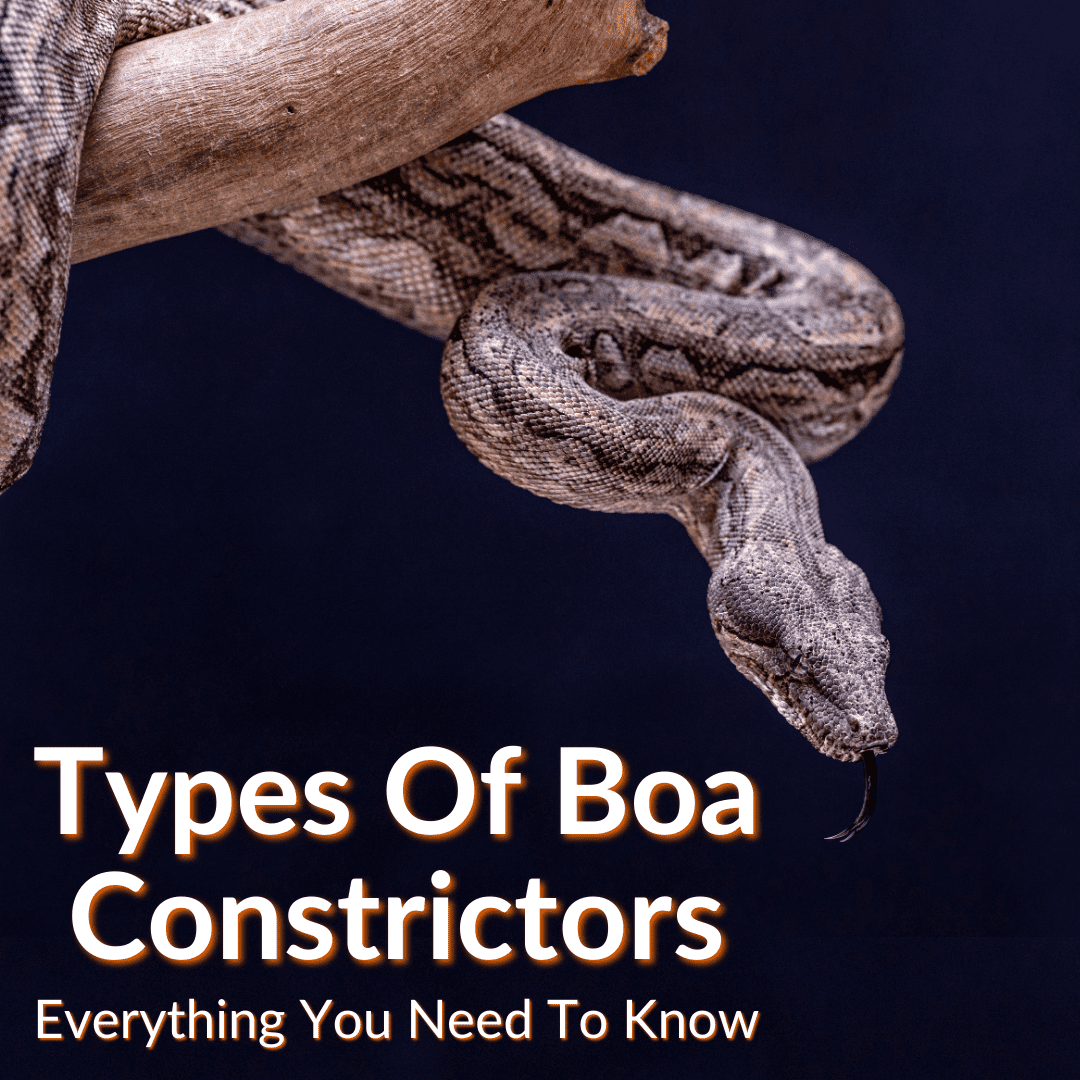
But there is no good reason for this.
Even the largest boas have no interest in harming us, much less eating us.
They may deliver a painful bite when threatened, but apart from pain and bacteria, the bite poses no real danger.
They certainly do not hunt and eat us, unlike what Hollywood would have you believe.
And many boas are actually quite small and can make excellent pets, even for beginners.
It simply depends on the type of boa constrictor in question.
Keep reading to learn all about the different types of boa constrictors, including which ones can make good pets for those with little, or even no, experience keeping snakes.
Table of Contents
- 1 Types Of Boa Constrictors
- 2 Different Kinds Of Boas: Final Thoughts
Types Of Boa Constrictors
We will take a close look at the different types of boas, including their physical characteristics, where they live, their habits, their diet, and their suitability as pets.
It is also important to note that boas and pythons are not the same. Our article comparing pythons vs boa constrictors goes into detail on the differences, as well as the similarities between the two snake families. We also have another article specifically comparing the ball python vs boa constrictor.
Rosy Boa
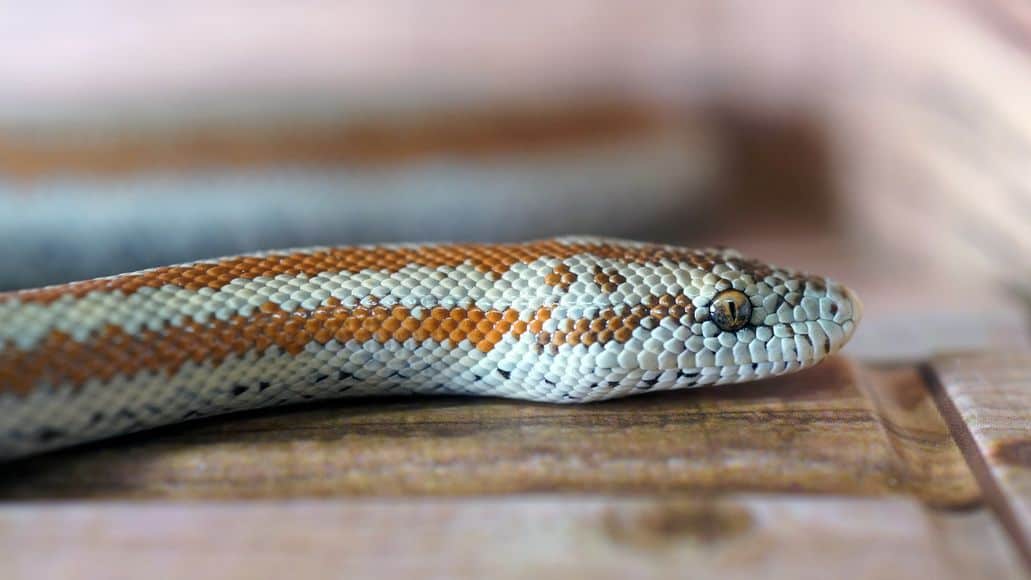
Scientific Name
Lichanura trivirgata
Size and Description
Rosy boas reach a length of 36 inches (up to 3 feet) in adulthood. They have pink bellies, which is what gives them their name. The rest of the body is tan, gray, or rusty with maroon stripes.
Area of Origin
Rosy boas are native to the southwestern US and Mexico. They are one of the two species of boa constrictors found in the USA, with the other being the Rubber boa discussed below.
Rosy boas are mainly found in California, Arizona, and Nevada. They are also seen in the coastal areas around Los Angeles. They prefer desert-like habitats and rocky outcroppings.
Habits
Rosy boas are diurnal in the spring but mostly nocturnal the rest of the year. They are nonvenomous but tend to release a foul-smelling musk when threatened. Rosy boas make excellent pets, because they are one of the most mild-mannered boas.
Diet
Rosy boas primarily eat mice or rats. They also eat small birds, lizards, amphibians, and other snakes.
Ease of Care
Rosy boas are great beginner pets since they are hardy, great feeders, and easy to breed. They are also docile and like being handled.
Rubber Boa
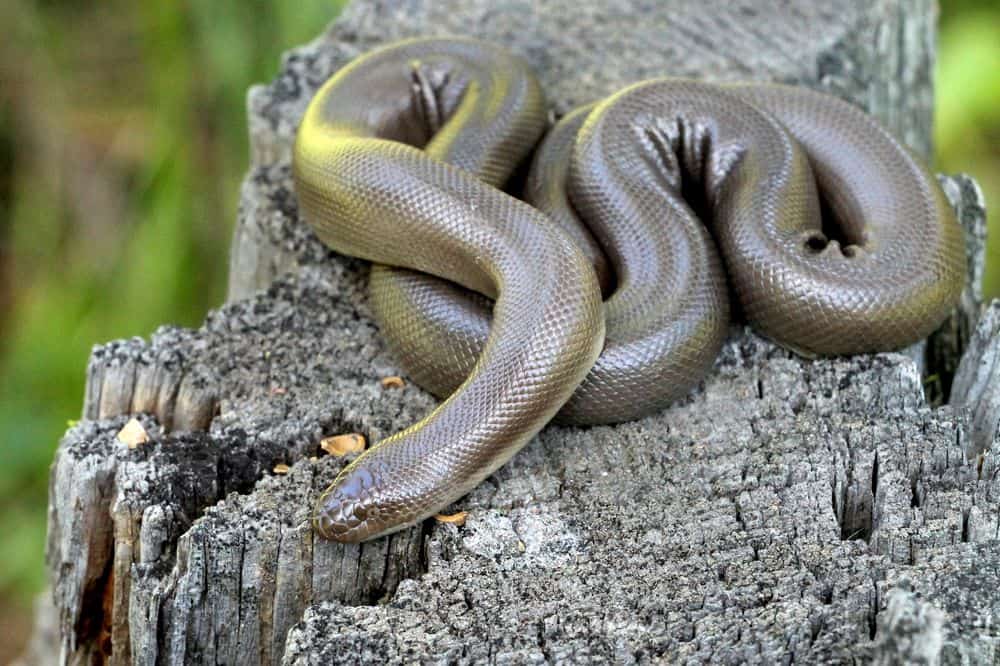
Scientific Name
Charina bottae. Charina means graceful!
Size and Description
Rubber boas are small, stout, and smooth snakes. They measure about 23.5 inches, on average. They come in shades of brown and have yellow bellies.
Area of Origin
As mentioned above, Rubber boas are native to North America. They are only one of the two species of boas in the USA. They are found from southern California to British Columbia.
Habits
Rubber boas prefer spending time in cool, dark, and moist places, such as under rocks and logs, and in caves and burrows. They are nocturnal hunters.
Diet
Rubber boas eat rodents, deer mice, shrews, voles, and other small mammals.
Ease of Care
The Idaho government cautions not to keep rubber boas as pets despite their docile natures. After all, they are wild animals that have very specific needs which you might not be able to fulfill.
Kenyan Sand Boa
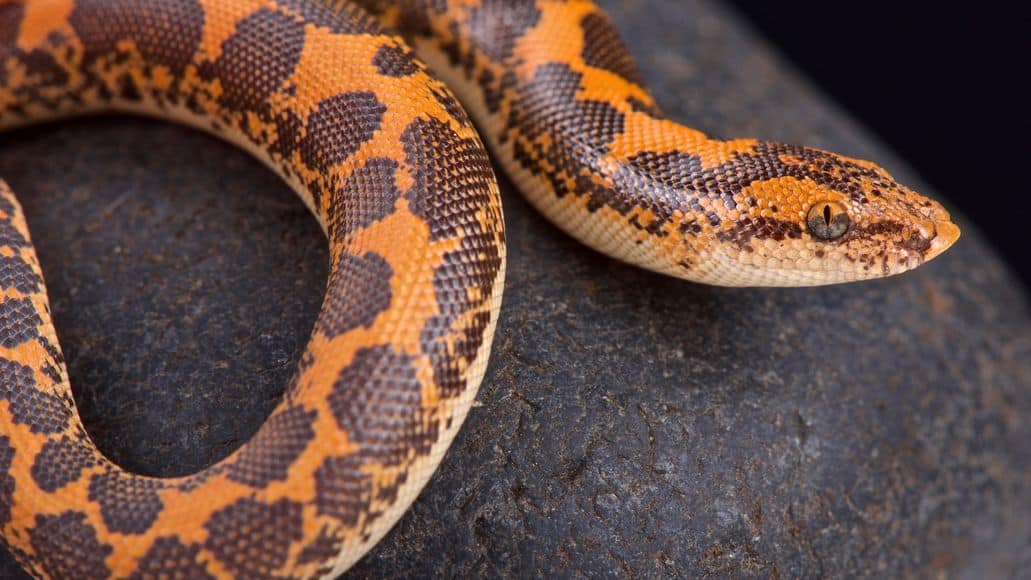
Scientific Name
Gongylophis colubrinus.
Size and Description
Kenyan Sand Boas are stout, thick-bodied snakes. Female Kenyan boas reach a length of 26 to 32 inches. Males, on the other hand, are about 15 inches long. These beautiful snakes have orange and brown speckled patterns running down their backs.
Area of Origin
The Gongylophis colubrinus prefers savannahs, deserts, scrublands, and dunes. They are found in northern and eastern Africa (Egypt, Sudan, Ethiopia) in areas with low vegetation and plenty of rock cover.
Habits
Kenyan boas are elusive, nocturnal snakes. They are also fossorial, meaning they burrow and hide underground.
Diet
Kenyan boas eat mice, rodents, small birds, and lizards.
Ease of Care
Kenyan boas make excellent pets. They tolerate being handled well. They are also excellent pets for beginners. They rarely bite and prefer to withdraw, hide, or jerk when they feel threatened. They also have a long life. Their behavior is also interesting to watch.
Red-Tailed Boas (Common Boas)
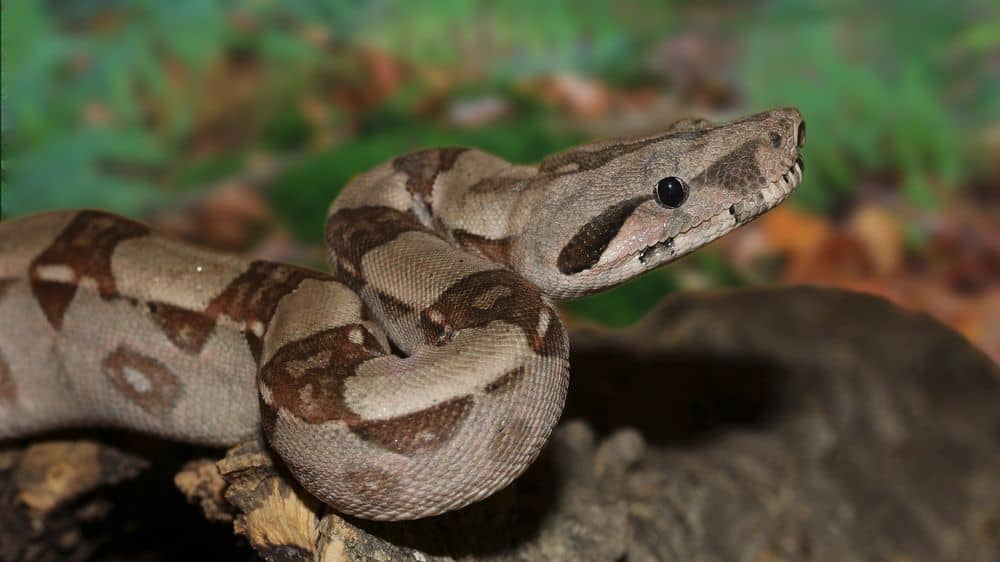
Scientific Name
Boa constrictor
Size and Description
Red-tails are some of the largest snakes in the world. Females measure between 7 and 9 feet, while males measure 6 to 8 feet. They are light brown-gray in color with a red tail.
Area of Origin
This large nonvenomous snake is native to South America.
Habit
Red-tailed boas are solitary and nocturnal.
Diet
Red-tailed boas are carnivorous snakes (like all snakes) that feed on mice, squirrels, opossums, bats, and birds.
Ease of Care
Red-tailed boas, despite their large size, can not and do not eat humans. They make excellent pets and can live for over 20 years with proper care and husbandry. They tolerate handling well and are fairly easy to care for. But they are huge and need a lot of space.
Rainbow Boas (Brazilian Rainbow Boas)
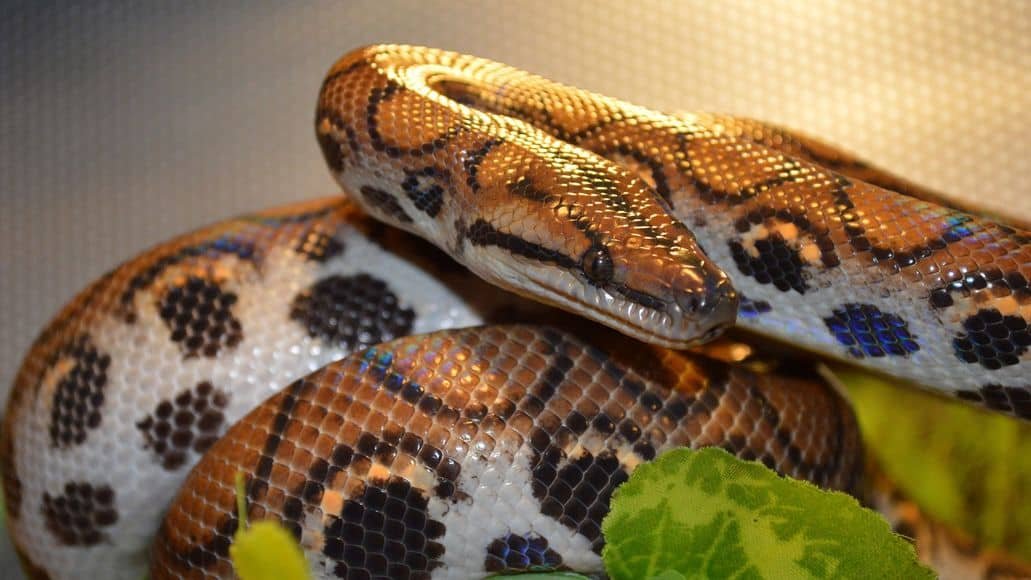
Scientific Name
Epicrates cenchria
Size and Description
The average rainbow boa measures 5 feet, or 1.5 meters. The reason for the snake’s name is that when light strikes this beautiful snake, it is dispersed in stunning rainbow colors.
Area of Origin
Rainbow boas are native to Brazil and other neighboring countries. You will also find rainbow boas in Peru, Columbia, Guana, and Argentina.
Habits
Rainbow boas are solitary, nocturnal, terrestrial creatures. In cooler months, they may come out to bask in the sun’s warmth in the daytime. They use their heat-sensing pits on their jaws to sense their prey.
Diet
In their natural habitats, rainbow boas eat small mammals, rodents, bats, birds, and lizards.
Ease of Care
Brazilian rainbow boas make excellent pets. They thrive in captivity, are docile, and generally like being handled.
Long-Tailed Boa Constrictor
Scientific Name
Boa constrictor longicauda
Size and Description
The long-tailed boa is a subspecies of the red-tailed boa. It can vary in length between 6.5 and 9.8 feet (1.9 to 3 meters). Female boas are longer than the males. Long-tailed boas have brown, gray, cream, black, or tan coloring and may have deep saddle-shaped stripes along the back.
Area of Origin
This species mainly inhabits the forests of Peru and the northern parts of Ecuador.
Habits
Long-tails are solitary, nocturnal creatures that occasionally venture out during the day to bask in the sun. They are semi-arboreal, meaning they often climb trees. However, as they get older and heavier, they prefer being on land.
Diet
What do boa constrictors eat? In the wild, long-tail boas eat small mammals like ocelots, rodents, lizards, and birds. In captivity, you can feed them mice or rats.
Ease of Care
Since they are large snakes, they aren’t beginner-friendly and may be better suited for intermediate or advanced herpetoculturists.
Bolivian Boa Constrictor (Brazilian Short Tail Boas)
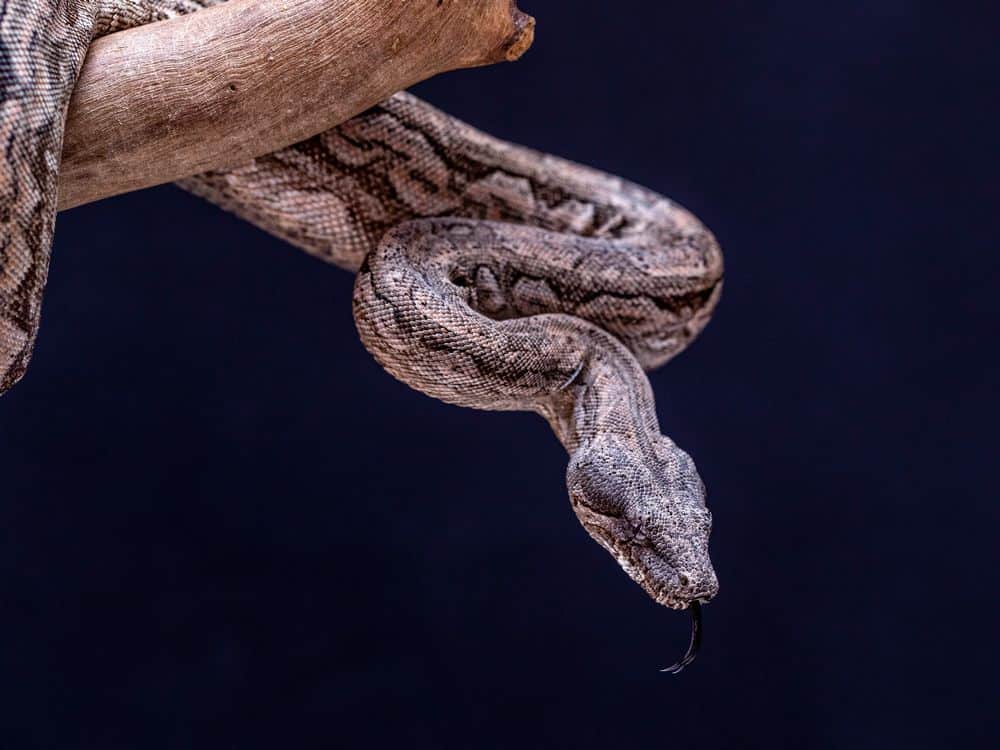
Scientific Name
Boa constrictor amarali
Size and Description
Brazilian boas are shorter and stouter than their Colombian and Guyana counterparts. Females measure about 5 to 6 feet (1.5 to 1.8 meters) while males are 4.5 to 5 feet long. They come in a variety of colors and patterns including broken or aberrant patterns, saddle patterns, etc.
Area of Origin
Brazilian short-tail boas are found in the Amazon basin of Brazil, in the state of Sao Paulo, and the southern parts of Serra dos Parecis.
Habits
Like other boa varieties, Brazilians are shy, nocturnal hunters. They are excellent swimmers but they avoid going into the water. They use their pits to detect warm-blooded prey at night.
Diet
Brazilian short-tailed boa constrictors feed on a variety of warm-blooded invertebrates.
Ease of Care
Brazilian boas are fairly easy to care for as long as you get their basic setup right. They are also beginner-friendly. However, if you are not comfortable handling large-bodied snakes, you may want to consider some of the smaller boas.
Colombian Boa Constrictor (Colombian Red-Tailed Boa)
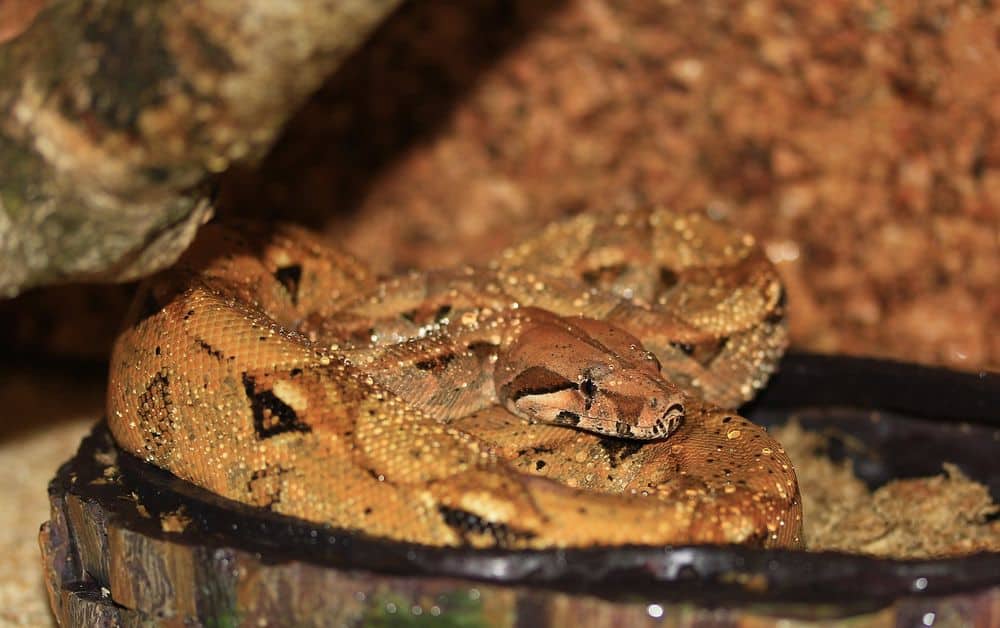
Scientific Name
Boa constrictor imperator
Size and Description
The average adult size for a female Colombian boa constrictor is 6 to 8 feet (1.8 to 2.4 meters) and males are usually smaller – about 5 to 7 feet (1.5 to 2.1 meters).
Colombian Red-Tailed boas are typically tan with around 20 dorsal saddles and with a red/orange/reddish-brown tail. Morphs are also available in beautiful colors.
There is generally a lot of confusion between this snake (often abbreviated BCI) and the boa constrictor constrictor (BCC). Our article comparing the boa imperator vs boa constrictor clears up the confusion.
Area of Origin
Colombian red-tails can be found throughout Central America, down to far northern Peru, and in the Sonoran Desert of Mexico.
Habits
Columbian red-tail boas are semi-arboreal. They usually live in hollow logs and burrows. Their large loosely-hinged jaws can stretch wide which enables them to swallow prey that is much larger than their head.
Diet
Columbian boas are known to eat small mammals including monkeys. They also eat iguanas, lizards, birds, and rodents.
Ease of Care
Due to their large size and long lifespans of up to 3 to 40 years, they are best suited for moderate-to-advanced keepers.
Amazon Tree Boa
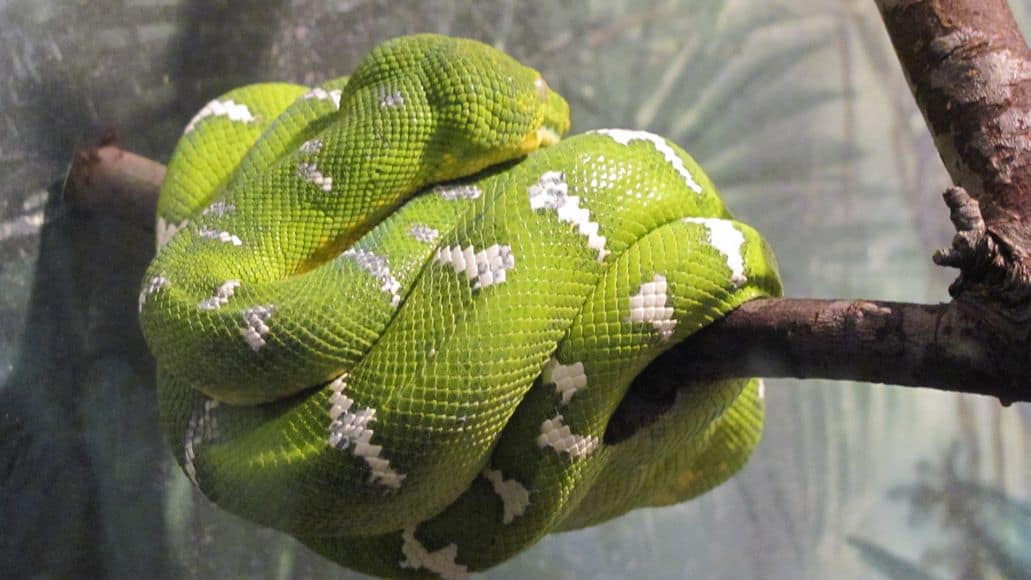
Scientific Name
Corallus hortulana
Size and Description
The average adult Amazon Tree Boa grows to a size 6 to 8 feet (1.8 to 2.4 meters), but they are quite thin. The variety of colors and patterns in this species is incredible.
Amazon Tree Boas can have gray, brown, yellow, red, or orange on their bodies. Bands, speckles, or chevron shapes are all common, but you can also find them with no patterns at all.
Area of Origin
This snake prefers elevations below 300 meters above sea level, It lives throughout the Amazon rainforest (as the name might suggest), in Brazil, Bolivia, Peru, Ecuador, Colombia, Venezuela, Guyana, Suriname, and French Guiana.
Habits
Their name also lets us know that they are a species of arboreal snakes. They spend most of their time in trees, usually at a height of one to two meters above the ground. They are active both at night and during the daytime.
Diet
Amazon Tree Boas like to eat bats, frogs, birds, lizards, and rodents.
Ease of Care
Amazon tree boas are fairly common as pets, but they are quite irritable and quick to bite. They also need a specific environment. As a result, they are not suited for beginners. They are a pet snake for keepers with a bit more experience.
Different Kinds Of Boas: Final Thoughts
Everyone has heard of the boa constrictor, thanks to numerous movies and TV series. Thanks to those same films and series, most believe the boa to be a deadly killer that spends its life hunting down unlucky humans.
Nothing could be further from the truth. Not only do boas have no interest in harming us and none have ever eaten a human, but the boa constrictor is not even a single species of snake. There are, in fact, many different types of boa constrictors.
The list above includes the most common species of boas. There are many others, though they are all subspecies of some of the species listed above. And many boas are actually relatively small and famous for being docile, making them excellent pets, even for beginners.

Leave a Reply